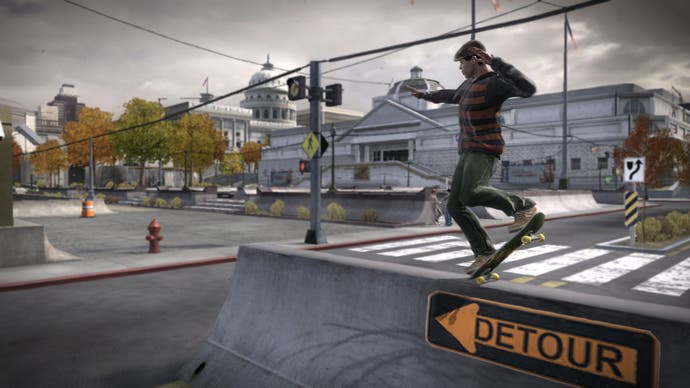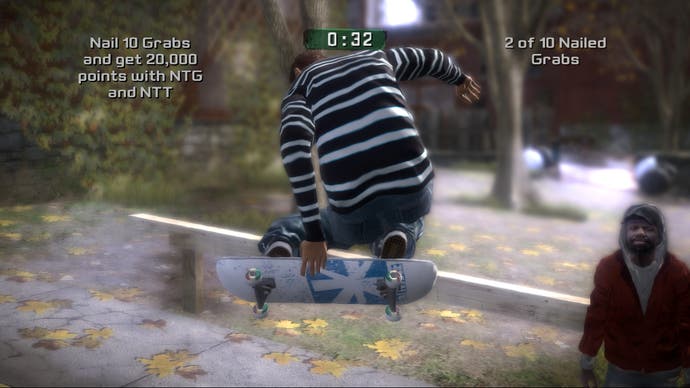Tony Hawk's Proving Ground
Keep on trucking.
Tony Hawk's Project 8 was like a fresh summer's morning, the last of the dew glistening on the luscious blades of grass, a warm sun emerging above the distant hills, while puffy white clouds dotted a rich blue sky. Through its fields and meadows you gaily skipped, pausing to pluck a large, happy-faced daisy and weave it into your hair, before busting a sick flip-trick off a convenient nearby quarter pipe in gorgeous slow motion.
Proving Ground is a cloudy, early Winter's day, with the worst of Autumn's drizzle over, but before it's become snugglingly cold. There's a fog on the horizon, grime on the streets, and a weighty cloud of melancholy hanging over all below.
It's peculiar that Proving Ground is so much less of a game than Project 8. Because if you look at what it offers - the impressive list of features, both those evolved and those new - it should by rights be a step forward. It is, however, a sort of sit down and stare at the wall. Added to the glorious Nail The Trick mode is a Nail The Grab, and a Nail The Manual. Then on top, there's the new Aggro Kick to offer speed boosts, Skate Checking for beating up innocents, Bowl Skating for old-skool Dogtown vibes, as well as Rigging - letting you manipulate your environment, build ramps and rails, and film it all, and finally the ability to get off your board and climb the cities to look for exciting new gaps. Oh, and the skate house. Oh again, and the video editing. Phew, eh? What a lot.
It's important to cover the new Nails. The original Trick mode is still entered by clicking both sticks, converting each analogue into one of your legs. Grab kicks in when you hold down the left trigger in Nail mode, and then the control switches to your hands. Grab tricks are given the same grace and freedom as feet juggling, with sweeping turns of the sticks letting you spin the board and catch it again at the right moment. Manual is on the right trigger, with each stick representing the weight each foot puts on either end of the board. Push down with one foot, land it, and then balance the manual with the sticks. You can leap up out of this, and be straight back into Trick mode, and indeed switch between all three in elaborate combos.

So why hasn't this made Proving Ground into the skateboarding game of the century? Let's explore. But with some rules. It remains a fine skateboarding sim, and there's a vast amount to do, in three huge city areas covering Philadelphia, Baltimore and Washington DC. What follows is why this falls short of the completely lovely Project 8, and not why it's a rubbish game that no one should buy. When expectations aren't met, or hopes are dashed, it's too easy to focus on the negatives, in a game that carries a hefty pocketful of positives.
If there's one thing that sums up the whole game, it's grime. This is, of course, a deliberate decision, in an attempt to bring the game a bit closer to the roots of skateboarding - urban, inner-city areas - the locations have been chosen for their realism. These are the kinds of places people really do skate, rather than, say, over the bows of ships, or on the rollercoasters of theme parks. The problem is two-fold. First, horrible grey cities might be much more true to the activity, but it looks horribly miserable on my 360. And second, what good realism when your game is predicated on anti-gravity superhero skating?

So for all its grisly, grey streets, you're still breaking into the museum and grinding the exhibits. You're still leaping off rooftops into fountains, entering slo-mo on the way down. You're still achieving the impossible in the company of the world's leading pro-skaters. So frankly, I miss those boats and rollercoasters.
This time the game's 'story' is about being a plucky young skater, who starts getting recognised by the pros in town, including Mr Hawk. As you play, you can improve your basic stats (which max out remarkably quickly), while you progress through four skill sets, each reflecting a different approach to skateboarding. There's Career - the professional route, gaining sponsorship deals, magazine coverage, television exposure, etc. Then Hardcore - skaters who are in it for the love of skating, and apparently the love of maiming strangers. There's Rigger - the improvisational sort who knocks together his own ramps out of a shopping trolley and piece of 2 by 4. And somewhat separately, there's Street - which is the catch-all for those on-the-spot challenges that you encounter everywhere you go.
The first three are improved upon by taking on challenges and tasks from the appropriate skaters. A Rigger might ask you to manipulate the street furniture until you can grind a lamppost onto a balcony, then take pictures of you as you jump some gaps from the rooftop. A Hardcore fellow might require you to get up some mean speed and clear a large gap. And so on, and as you make your way through these mini-stories, you gain experience points which can be spent on boosting the core skills you've learned. So following the Career path will open up the Nail the Trick, then Grab, then Manual modes. Spend points on these and you'll be able to unlock their "Perfect" modes, or gain extra point-scoring options like a body-spin for Trick, or "trucks up grab" for Grab.

Unfortunately, these tasks are a massively uninspired collection, with most of the fun Project 8 challenges gone, replaced with incessant use of the tiresome "perform the trick as I call it out" missions. Even the most fun tasks, like scoring as many points as possible using Nail The Trick, are hindered by a peculiar insistence on forcing you to do them in super-high pressure situations, like during a plunging acid drop. While certainly tough to pull off, they're not a great deal of fun. In fact, what they do is reduce the freeform improvisational bliss of the Nail mode to the intricate button mashing from which it had so joyously freed us.
The Rigging tools are pretty poor. Putting down ramps and rails shouldn't be a massive challenge, but you'll spend half the time screaming at the stupid thing for somehow refusing to stay at the height you set it, or for madly getting stuck under some scenery. And the challenges that involve it rarely extend beyond throwing down enough rails in a row so you can grind past trouble. The same mode lets you augment your skate house - a vast barn in which you can spend your winnings on ramps and rails for building your own indoor park, or on daft decorations, furniture, and twenty-foot wide televisions (seriously - I spent $20,000 on one, and all it shows are adverts for skate companies). The notion here is you create the ultimate pad, and then invite in your jealous chums via the magic of Xbox Live. To be honest, that may appeal to some, but it all seemed a lot of fuss, and with the rigging tools so annoying, the desire ran out at the wall-sized screen, and a sofa in front of it.


